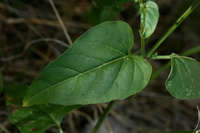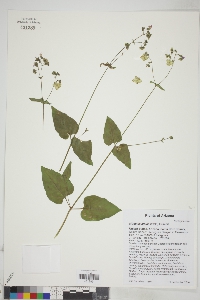|
|
 Leaves Patrick Alexander @http://swbiodiversity.org, Usage Rights: Creative Commons Attribution-ShareAlike (CC BY-SA) |  Plant University of Arizona Herbarium, Usage Rights: CC BY-NC (Attribution-Non-Commercial) | | | | |
|
Origin:
Native
Life Cycle:
Perennial
General Desc:
Perennial herb, 2-1/2 to 5 feet tall; stems erect to decumbent (trailing with tip ascending), branching; herbage often hairy, especially the upper portions of the plant.
Identification notes: Typically well branched, stems erect to trailing; leaves opposite, narrow, oval or triangular, hairy or not; whorl of bracts below flowers green or blushed with red, covered with light hairs, flowers terminal or in leaf axils; fruits hairy, 5-ribbed.
Height:
2-1/2 to 5 feet
Habitat Description: Found in dry meadows, sandy prairies, hillsides, rocky soils, and often on slopes.
Plant Communities:
Interior Chaparral, Semidesert Grasslands, Pinyon Juniper Woodland, Montane Conifer Forest
Elevation: 3500 - 6500 feet
Color:
White to pink or purple
Shape:
Regular in elongated clusters
Tubular:
Y
Flowering Period:
May - Oct
Description:
White to pink or purple, in clusters at end of stem, or occasionally solitary in leaf axils, each cluster of 2 to 3 flowers is enclosed by a bell-shaped involucre (cup-like whorl of bracts), on hairy stalks, 1/16 to 1 inch long; 5 stamens.
Leaf Color:
Green to blue-gray
Leaf Type:
Simple
Leaf Shape:
Triangular
Leaf Margin:
Smooth
Leaf Attachment:
Opposite
Leaves Clasp:
N
Hairs:
Leaves and stems
Spines:
N
Leaf Description:
Opposite and stalkless or on stalks up to 1-1/2 inches long; blades narrow to oval or triangular, 1/2 to 4 inches long, green to glaucous (waxy) blue-gray, smooth to hairy, thin and fleshy to thick and leathery, 2 per stem node.
Fruit Color: Brown to dark brown
Fruit Type: Achene
Fruit Notes: Achenes 1/4 inch long, obovoid (egg-shaped, broader at tip) with 5 longitudinal ribs, surface brown to dark brown with pale tan, brown, or dark brown ribs, hairy, and usually wrinkled or covered with warts; fruit is dry but does not split open when ripe.
|
|